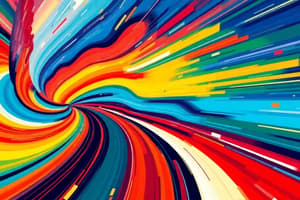Podcast
Questions and Answers
What is a key difference between a scalar and a vector?
What is a key difference between a scalar and a vector?
- A scalar is always positive, while a vector can be positive or negative.
- A scalar is always negative, while a vector can be positive or negative.
- A scalar has direction, while a vector has magnitude.
- A scalar has magnitude, while a vector has both magnitude and direction. (correct)
Which of the following is an example of a scalar?
Which of the following is an example of a scalar?
- Speed (correct)
- Momentum
- Acceleration
- Velocity
What is the direction of displacement when a ball is thrown off a cliff and is below the cliff top?
What is the direction of displacement when a ball is thrown off a cliff and is below the cliff top?
- Negative (correct)
- Positive
- Zero
- Undefined
What is velocity?
What is velocity?
Why is a car accelerating while traveling at constant speed around a roundabout?
Why is a car accelerating while traveling at constant speed around a roundabout?
What represents the magnitude of a vector?
What represents the magnitude of a vector?
What type of force is gravitational attraction?
What type of force is gravitational attraction?
What causes friction between two objects?
What causes friction between two objects?
Flashcards are hidden until you start studying
Study Notes
Vectors and Scalars
- A vector has both magnitude and direction.
- A scalar has only magnitude.
- Scalars are generally non-negative, but vectors can be negative as they have a direction associated with them.
Examples of Vectors and Scalars
- Speed is a scalar quantity.
- Velocity is a vector quantity.
- Distance is a scalar quantity.
- Displacement is a vector quantity.
- Time is a scalar quantity.
- Momentum is a vector quantity.
- Acceleration is a vector quantity.
- Energy is a scalar quantity.
- Force is a vector quantity.
- Mass is a scalar quantity.
Displacement and Velocity
- Displacement can be negative if the direction is considered (e.g., a ball thrown off a cliff).
- The zero point of a vector can be chosen arbitrarily, depending on the context (e.g., setting the zero point at the bottom of a cliff).
- Velocity is speed with direction (e.g., 10 m/s vs. 10 m/s at 30° above the horizontal).
- Even if the speed is constant, the velocity can change if the direction changes (e.g., a car traveling around a roundabout).
Representing Vectors
- Vectors can be represented by arrows, with their size/length representing the vector magnitude.
Object Interaction
Forces
- A force is a push or pull that acts on an object due to interaction with another object.
- Forces can be classified into two types:
- Non-Contact Forces:
- Electrostatic forces (caused by charges)
- Gravitational forces (caused by mass)
- Contact Forces:
- Normal contact force (opposite direction to contact)
- Friction (caused by surface roughness when moving in contact)
- Non-Contact Forces:
Studying That Suits You
Use AI to generate personalized quizzes and flashcards to suit your learning preferences.




